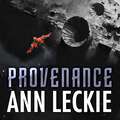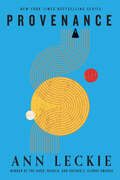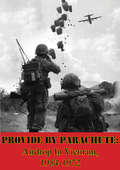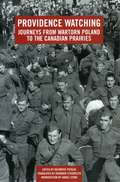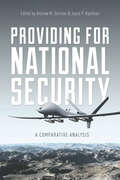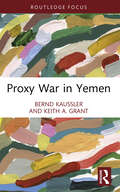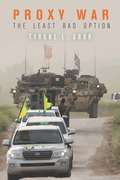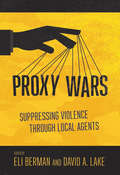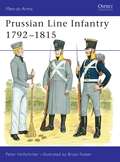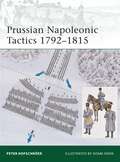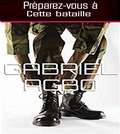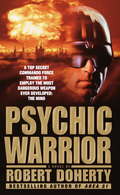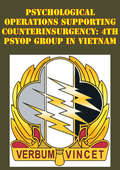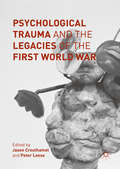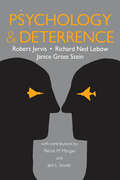- Table View
- List View
Provenance: A new novel set in the world of the Hugo, Nebula and Arthur C. Clarke Award-Winning ANCILLARY JUSTICE
by Ann LeckieSHORTLISTED FOR THE HUGO AWARD FOR BEST NOVEL 2018SHORTLISTED FOR THE LOCUS AWARDS 2018 SHORTLISTED FOR THE BSFA AWARDS 2018 'Excellent' Book Smugglers 'A fitting addition to the Ancillary world' NPR 'Gripping . . . richly detailed and rewarding' SciFiNow 'Thrilling, out-of-this world stuff' Stylist Following her record-breaking debut trilogy, Ann Leckie, winner of the Hugo, Nebula, Arthur C. Clarke and Locus Awards, returns with a thrilling new story of power, theft, privilege and birthright. A power-driven young woman has just one chance to secure the status she craves and regain priceless lost artefacts prized by her people. She must free their thief from a prison planet from which no one has ever returned. Ingray and her charge will return to their home world to find their planet in political turmoil, at the heart of an escalating interstellar conflict. Together, they must make a new plan to salvage Ingray's future, her family, and her world, before they are lost to her for good. The Imperial Radch trilogy begins with Ancillary Justice, continues in Ancillary Sword and concludes with Ancillary Mercy. Also available now: Provenance is a stunning standalone adventure set in the same world as Ancillary Justice. NPR calls it 'A fitting addition to the Ancillary world'.
Provenance: Booktrack Edition
by Ann LeckieFollowing her record-breaking debut trilogy, Ann Leckie, winner of the Hugo, Nebula, Arthur C. Clarke and Locus Awards, returns with an enthralling new novel of power, theft, privilege and birthright. A power-driven young woman has just one chance to secure the status she craves and regain priceless lost artifacts prized by her people. She must free their thief from a prison planet from which no one has ever returned. Ingray and her charge will return to her home world to find their planet in political turmoil, at the heart of an escalating interstellar conflict. Together, they must make a new plan to salvage Ingray's future, her family, and her world, before they are lost to her for good.For more from Ann Leckie, check out:Imperial RadchAncillary JusticeAncillary SwordAncillary Mercy
Provide by Parachute: Airdrop In Vietnam, 1954-1972
by Major John A. TokarThe study of history is a resource that most agree is critical to the betterment of any organization. The U.S. Army has always embraced military history, and by studying the "lessons-learned" from past wars and operations it improves its ability to perform in the future. However, the bulk of rewarding historical military study and education has been devoted to combat operations, at the expense of other fields, such as logistics. Moreover, there has been sparse accounting of logistical operations during the Vietnam War. The use of airdrop was not widespread in Vietnam, but significant developments in aerial resupply doctrine and technology were experienced. This monograph analyzes the airdrop operations at Dien Bien Phu in 1954, Khe Sanh in 1968, and An Loc in 1972, and presents the doctrinal and procedural evolution that occurred in each. All three battles presented unique challenges to the logisticians tasked to resupply the beleaguered forces, and the solutions that emerged were equally remarkable.The story of aerial resupply, tactical airlift, and airdrop in Vietnam is largely a story of success in a place and time where (at least strategically and politically) there were few positive achievements. Many of the ideas and tenets employed to relieve besieged forces there were the result of the resourcefulness and ingenuity of Army and Air Force logisticians and aircrews. Some of these methods were incorporated into procedures for future use, but many were not. This study captures these experiences, through an historical analysis of the missions themselves, with the intent of improving the current logistics posture of U.S. forces and their ability to "provide by parachute."
Providence Watching: Journeys from Wartorn Poland to the Canadian Prairies
by Daniel Stone Kazimierz Patalas Zbigniew IzydorczykAt the start of the Second World War, Poland was invaded by both the German and the Soviet armies. The country was unable to withstand the assaults and thousands of Polish soldiers and civilians were shipped to labour camps and prisons, where starvation, disease, and mistreatment were their daily expectations. With the signing of an amnesty between the Polish and Soviet governments in 1942, many of these soldiers were engaged in rebuilding the Polish army, and travelled through the Mideast to fight in the Italian campaign.After the war, Canada accepted over 4000 Polish immigrant soldiers and their families who did not want to return to a communist regime in their country. This book is a moving oral history of the experiences of forty-five individuals during that transition period between the outbreak of war and their eventual relocation in Canada. Their memories of those times remain clear, not so remarkably perhaps, as they recount how they struggled in labour and prison camps, refugee camps, and exile in freezing northern climates, often arriving with the clothes they wore and nothing else. There are stories here of families torn apart and reunited, courageous escapes, underground resistance, friendship and emnity, and above all of survival. To read these memoirs is to understand how the inhumanity of war is confronted and defied by the indomitable human spirit.
Providing For The Casualties Of War: The American Experience Through World War Ii
by Bernard RostkerWar has always been a dangerous business, bringing injury, wounds, and death, and--until recently--often disease. What has changed over time, most dramatically in the last 150 or so years, is the care these casualties receive and who provides it. This book looks at the history of how humanity has cared for its war casualties and veterans, from ancient times through the aftermath of World War II.
Providing for National Security: A Comparative Analysis
by Joyce P. Kaufman Andrew M. DormanProviding for National Security: A Comparative Analysis argues that the provision of national security has changed in the 21st century as a result of a variety of different pressures and threats. In this timely volume experts from both the academic and policy worlds present 13 different country case studies drawn from across the globe—including established and newer states, large and smaller states, those on the rise and those in apparent decline—to identify what these key players consider to be their national security priorities, how they go about providing national security, how they manage national security, and what role they see for their armed forces now and in the future. The book concludes that relative standing and the balance of power remains important to each state, and that all see an important role for armed forces in the future.
Proxy War in Yemen (Cass Military Studies)
by Keith A. Grant Bernd KausslerThis book analyzes the civil war in Yemen and how intervening external actors have shaped the trajectory of the conflict. The work examines the conflict in Yemen as a testing ground for expectations about the autonomy and control of proxies by external patrons and the direct consequences for civilian victimization and duration of war. Like other proxy wars, the international dimensions of the war made the conflict in Yemen subject to the geopolitical interests of intervening powers. The longstanding power rivalry between Saudi Arabia and Iran over Middle East supremacy resulted in a competitive intervention in Yemen, where the initial belligerents of the civil war—the Houthi and the Hadi regime—were used as proxies by Tehran and the Gulf coalition led by Riyadh, respectively. Their intervention ultimately translated into a prolonged and destructive conflict. The often contradictory and self-interested patronage strategies by the coalition’s two central patrons, Saudi Arabia and the United Arab Emirates, undermined their broader goal of containing Iran. However, Iran’s support for the Houthis enabled them to bait and bleed the Gulf coalition. Lastly, in an effort to balance against Iran, the United States underwrote the military campaign of the Gulf states with military hardware and personnel, thereby further prolonging the conflict and humanitarian disaster. This book concludes that intervention by external patrons both protracted the civil war and made it far more destructive for the civilian population. This book will be of much interest to students of proxy wars, Middle Eastern conflict, and security studies in general.
Proxy War: The Least Bad Option
by Tyrone L. GrohThe U.S. has indirectly intervened in international conflicts on a relatively large scale for decades. Yet little is known about the immediate usefulness or long-term effectiveness of contemporary proxy warfare. In cases when neither direct involvement nor total disengagement are viable, proxy warfare is often the best option, or, rather, the least bad option. Tyrone L. Groh describes the hazards and undesirable aspects of this strategy, as well as how to deploy it effectively. Proxy War explores the circumstances under which indirect warfare works best, how to evaluate it as a policy option, and the possible risks and rewards. Groh offers a fresh look at this strategy, using uncommon and understudied cases to test the concepts presented. These ten case studies investigate and illustrate the different types and uses of proxy war under varying conditions. What arises is a complete theoretical model of proxy warfare that can be applied to a wide range of situations. Proxy war is here to stay and will likely become more common as players on the international stage increasingly challenge U.S. dominance, making it more important than ever to understand how and when to deploy it.
Proxy Warriors: The Rise and Fall of State-Sponsored Militias
by Ariel I. AhramThis work by Ahram (international and area studies, U. of Oklahoma) constructs and tests a theory to account for variation in the use of state-sponsored militias versus conventional armed forces among late-developing states. He argues that when decolonization occurred through violent revolution leaving guerrilla groups in place, the state tended to appropriate guerrilla networks into state militias, whereas when decolonization happened through negotiation with the departing power, the state tended to inherit the bureaucratic military organizational format of the former colonial government. These inherited structures are further influenced by external conditions, with the strong threat of war tending to lead to the centralization of state coercive power and relatively pacific international environments tending to lead to devolution in military power and the use of state-sponsored militias for facing internal threats. The theory is tested against the cases of Indonesia, Iraq, and Iran. Annotation ©2011 Book News, Inc. , Portland, OR (booknews. com)
Proxy Wars: Suppressing Violence through Local Agents
The most common image of world politics involves states negotiating, cooperating, or sometimes fighting with one another; billiard balls in motion on a global pool table. Yet working through local proxies or agents, through what Eli Berman and David A. Lake call a strategy of "indirect control," has always been a central tool of foreign policy. Understanding how countries motivate local allies to act in sometimes costly ways, and when and how that strategy succeeds, is essential to effective foreign policy in today's world. In this splendid collection, Berman and Lake apply a variant of principal-agent theory in which the alignment of interests or objectives between a powerful state and a local proxy is central. Through analysis of nine detailed cases, Proxy Wars finds that: when principals use rewards and punishments tailored to the agent's domestic politics, proxies typically comply with their wishes; when the threat to the principal or the costs to the agent increase, the principal responds with higher-powered incentives and the proxy responds with greater effort; if interests diverge too much, the principal must either take direct action or admit that indirect control is unworkable. Covering events from Denmark under the Nazis to the Korean War to contemporary Afghanistan, and much in between, the chapters in Proxy Wars engage many disciplines and will suit classes taught in political science, economics, international relations, security studies, and much more.
Prussian Cavalry of the Napoleonic Wars
by Peter Hofschroer Bryan FostenWhen Frederick II (later known as Frederick the Great) came to the throne in 1740, he had three advantages for which he owed thanks to his father: a modern, well-organised state; full coffers; and a properly trained and equipped army. Under a leader as renowned as Seydlitz, the Prussian cavalry achieved the nearest to a state of perfection that it was ever going to. So great was its reputation in the Seven Years' War that Napoleon made a special point of warning his men at the beginning of the 1806 campaign to beware of the Prussian cavalry.
Prussian Light Infantry 1792-1815
by Peter Hofschroer Bryan FostenThe Prussian light infantry branch was founded in the reign of Frederick the Great (1740-1786) and continued to develop from then onwards. It was the light troops of the Austrian army, the Croatian border soldiers, which so impressed Frederick in the Seven Years' War (1756-1763) that he considered it necessary to create an effective counter-force. Initially, there was a degree of reluctance amongst certain sections of the army towards this formation of light infantry. However, the Fusilier Battalions came to be regarded as elite formations, being well-trained, disciplined and carefully selected men led by young, fit and intelligent officers. This book describes in detail the uniforms, organization, training and weapons of this spectacular force.
Prussian Line Infantry 1792-1815
by Peter Hofschroer Bryan FostenAt the beginning of this period, the battalions of the Prussian Line usually fought in a linear formation three ranks deep, overwhelming the enemy with fire before a well-timed bayonet attack. By the end, the preferred formation was eight to 12 ranks deep. The responsibility for conducting the fire-fight was now given to the skirmish elements and the artillery. The formed battalions provided support for the fire line, and conducted the decisive bayonet charge. Whatever the change, the spirit and ability of the infantry remained consistently high throughout this bloody period.
Prussian Napoleonic Tactics 1792-1815
by Adam Hook Peter HofschröerWritten by an expert on the Prussian army of the Napoleonic era, this is a fascinating insight into the 18th-century evolution of the Prussian forces into the war-winning troops of the final battles against Napoleon. Using contemporary materials including drill regulations, instructions, staff and regimental histories and after-action reports, this book provides a compelling history of Prussian tactics from 1792 until 1815. It includes studies of the professional Prussian army during the Revolutionary Wars and the mass mobilization of a conscript army that fought during the Wars of Liberation and Waterloo. Following on from the success of Osprey's other Elite Tactics volumes, this is a must-have for serious students of Napoleonic warfare, armchair generals, and wargamers alike.
Prussian Reserve, Militia & Irregular Troops 1806-15
by Peter Hofschroer Bryan FostenIrregular, semi-regular and reserve formations comprised a substantial part of the armed forces at the disposal of the Prussian Army throughout the Napoleonic Wars, particularly during the campaigns of the Wars of Liberation, 1813-15. The scale of the uprising of 1813 required the mobilization of all available forces and the utilization of all available equipment, and meant that the Prussian Army of the Wars of Liberation was very much a patchwork affair. This book examines and illustrates the reservists (or Kruemper), the Freikorps and foreign units, and the militia who fought in the Prussian Army.
Prussian Staff & Specialist Troops 1791-1815
by Christa Hook Peter HofschroerThe origins of what would become the German General Staff of the late 19th and 20th centuries - probably the most professional military machine in the world - can be traced to the Prussian Army of the French Revolutionary (1792-1802) and Napoleonic Wars (1799-1815). This concise study, concluding the author's series of five titles on the Prussian Army of 1792-1815, covers the staff; the reforms in tactical employment of all-arms brigades (which, contrary to received opinion, pre-dated the disasters of Jena and Auerstedt in 1806); the artillery and other technical troops; and regimental colours and standards. Among the illustrations are rare diagrams from the artillery drill manual of the day.
Przemysłowa Concentration Camp: The Camp, the Children, the Trials (The Holocaust and its Contexts)
by Johannes-Dieter Steinert Katarzyna PersonThis book explores one of the most notorious aspects of the German system of oppression in wartime Poland: the only purpose-built camp for children under the age of 16 years in German-occupied Europe. The camp at Przemysłowa street, or the Polen-Jugendverwahrlager der Sicherheitspolizei in Litzmannstadt as the Germans called it, was a concentration camp for children. The camp at Przemysłowa existed for just over two years, from December 1942 until January 1945. During that time, an unknown number of children, mainly Polish nationals, were imprisoned there and subjected to extreme physical and emotional abuse. For almost all, the consequences of atrocities which they endured in the camp remained with them for the rest of their lives. This book focuses on the establishment of the camp, the experience of the child prisoners, and the post-war investigations and trials. It is based on contemporary German documents, post-war Polish trials and German investigations, as well as dozens of testimonies from camp survivors, guards, civilian camp staff and the camp leadership
Préparez-vous à cette bataille
by Gabriel AgboÊtes-vous prêt au combat ? Soyez toujours prêt. Nous ne devons rien tenir pour acquis. Oui, la vie est une guerre, et comme dans toute guerre, il y a toujours de nombreuses batailles à mener. Quand vous en gagnez une, vous vous préparez ou vous passez à la suivante. Jusqu'à ce que vous gagniez la guerre entière. Ici, vous saurez pourquoi la guerre et vous apprendrez aussi les principes de la victoire des batailles de la vie. Salomon est devenu le roi le plus sage, le plus riche, le plus influent et le plus célèbre du monde. Avec ce genre de bonne volonté et de ressources, il est allé de l'avant et a construit une grande armée. Ouah ! Il était donc aussi un stratège militaire ? Oui ! Maintenant, pourquoi ce roi ne peut-il pas profiter de 40 ans de règne pacifique et prospère ? Tenter de l'attaquer, lui ou son royaume, aurait été une mission suicidaire à haut risque pour n'importe qui ou n'importe quelle nation. Quels étaient ses secrets et sa stratégie ? Nous devons toujours être prêts. Notre Dieu est un guerrier et nous devons voir les choses comme Lui les voit. Nous devons nous rapprocher de lui et apprendre comment il mène ses batailles. Nous avons également examiné les politiques de défense de pays comme les États-Unis d'Amérique. Pourquoi est-ce aujourd'hui la seule superpuissance mondiale ? Quelle est l'importance de son budget et de ses activités de défense ? Que fait-elle de bien ? Vous verrez également les chapitres révélateurs suivants : L'Éternel est un guerrier, Préparez-vous à la guerre, Louange, gratitude et humilité, Êtes-vous bien organisé ? Les hommes, le matériel et la stratégie et répartissez-les. Savez-vous que Dieu vous a donné la connaissance comme capital et comme sécurité ? Et comment pouvez-vous le déployer ? Vous devez lire ce livre.
Psychiatric Casualties: How and Why the Military Ignores the Full Cost of War
by Professor Mark Russell Professor Charles FigleyThe psychological toll of war is vast, and the social costs of war’s psychiatric casualties extend even further. Yet military mental health care suffers from extensive waiting lists, organizational scandals, spikes in veteran suicide, narcotic overprescription, shortages of mental health professionals, and inadequate treatment. The prevalence of conditions such as post–traumatic stress disorder is often underestimated, and there remains entrenched stigma and fear of being diagnosed. Even more alarming is how the military dismisses or conceals the significance and extent of the mental health crisis.The trauma experts Mark C. Russell and Charles Figley offer an impassioned and meticulous critique of the systemic failures in military mental health care in the United States. They examine the persistent disconnect between war culture, which valorizes an appearance of strength and seeks to purge weakness, and the science and treatment of trauma. Instead of reckoning with the mental health crisis, the military has neglected the needs of service members. It has discharged, prosecuted, and incarcerated a large number of people struggling with the psychological realities of war, and it has inflicted humiliation, ridicule, and shame on many more. Through a far-reaching historical account, Russell and Figley detail how the military has perpetuated a self-inflicted crisis. The book concludes with actionable prescriptions for change and a comprehensive approach to significantly improving military mental health.
Psychic Warrior
by Robert DohertyHE'S THE ULTIMATE COMMANDO: INVISIBLE. INVULNERABLE. INVINCIBLE.PSYCHIC WARRIORIn 1981 psychics were secretly gathered in a classified military facility to "remote-view" enemy targets. It didn't work. Project Grill Flame was disbanded. Or so the public was told. That was a lie. Renamed Bright Gate, today it is a top secret operation few know exists. Its objective is to produce a virtual soldier who can leave his body behind, go anywhere, and do anything by harnessing the power of the mind. It is now operational. But the Russians have done it first, unleashing on the world the ultimate virtual killer. He calls himself Chyort--"Devil." Drawing on a multitude of new abilities, this psychic assassin has gained access to a secret weapon capable of unleashing an unstoppable, undetectable nuclear arsenal. Only Sergeant Major Jimmy Dalton, a battle-hardened Ranger with nothing left to live for but his honor, can stop him by accepting a dangerous mission: Lead a team of Psychic Warriors...and stop the Devil for us all.From the Paperback edition.
Psychoanalysis, Historiography, and the Nazi Camps: Accounting for Survival (The Holocaust and its Contexts)
by Dan StoneIn the postwar years, Dutch survivors Eddy de Wind, Louis Micheels, and Elie A. Cohen, who went on to become practicing psychoanalysts, penned accounts of their survival of the Nazi camps. Their sober assessments contrast sharply with those by Bruno Bettelheim and Viktor Frankl, which emphasized decisiveness, 'positive thinking', and resistance, missing the fact that many Holocaust victims with those characteristics or other qualities did not survive. De Wind’s, Micheels’ and Cohen’s accounts are more sober, (self-)critical, and shaped by analytical practice. By analyzing them anew and comparing them with accounts by female doctors who survived Block 10 in Auschwitz, this book argues that their theories of survival accord with contemporary sensibilities in psychoanalysis and Holocaust historiography. Psychoanalytic concepts have changed over time in response to greater understanding of the Holocaust and recent Holocaust historiography makes us more receptive to insights that were unfashionable in the first postwar decades.
Psychological Operations Supporting Counterinsurgency: 4th Psyop Group In Vietnam
by Major Michael G. BargerMilitary and civilian agencies conducted Psychological Operations on an unprecedented scale during the Vietnam War. Emphasis on PSYOP from MACV and the U.S. Mission resulted in the creation of an interagency organization providing direction to the overall PSYOP effort. The military PSYOP force supporting MACV underwent a series of organizational changes over seven years as the force struggled to meet ever-increasing demands, but never reached their full potential in Vietnam. Difficulties in measuring effectiveness combined with a lack of understanding of PSYOP techniques and capabilities more often than not resulted in the relegation of PSYOP to supporting "sideshow" status rather than the full integration into supported unit planning necessary for success. However, the evolution of the PSYOP force and reports from participants provide numerous lessons learned applicable to current operations under the aegis of the Global war on Terrorism.
Psychological Trauma and the Legacies of the First World War
by Peter Leese Jason CrouthamelThis transnational, interdisciplinary study of traumatic neurosis moves beyond the existing histories of medical theory, welfare, and symptomatology. The essays explore the personal traumas of soldiers and civilians in the wake of the First World War; they also discuss how memory and representations of trauma are transmitted between patients, doctors and families across generations. The book argues that so far the traumatic effects of the war have been substantially underestimated. Trauma was shaped by gender, politics, and personality. To uncover the varied forms of trauma ignored by medical and political authorities, this volume draws on diverse sources, such as family archives and narratives by children of traumatized men, documents from film and photography, memoirs by soldiers and civilians. This innovative study challenges us to re-examine our approach to the complex psychological effects of the First World War.
Psychological Trauma and the Legacies of the First World War
by Jason Crouthamel and Peter LeeseThis transnational, interdisciplinary study of traumatic neurosis moves beyond the existing histories of medical theory, welfare, and symptomatology. The essays explore the personal traumas of soldiers and civilians in the wake of the First World War; they also discuss how memory and representations of trauma are transmitted between patients, doctors and families across generations. The book argues that so far the traumatic effects of the war have been substantially underestimated. Trauma was shaped by gender, politics, and personality. To uncover the varied forms of trauma ignored by medical and political authorities, this volume draws on diverse sources, such as family archives and narratives by children of traumatized men, documents from film and photography, memoirs by soldiers and civilians. This innovative study challenges us to re-examine our approach to the complex psychological effects of the First World War.
Psychology and Deterrence (Perspectives on Security)
by Robert Jervis Richard Ned Lebow Janice Gross SteinDetterence is the most basic concept in American foreign policy today. But past practice indicates it often fails to work - and may increase the risk of war. Psychology and Deterrence reveals this stratgy's hidden and generally simplistic assumptions about the nature of power and aggression, threat and response, and calculation and behavior in the international arena.Most current analysis, the authors, note, ignore decisionmakers' emotions, preceptions, and domestic political needs, assuming instead that people repond to crisis in highly rational ways. Examining the historical evidence from a psychological perspective, Psychology and Deterrence offers case studies on the origins of World War I, the 1973 Arab-Israeli conflict, and the Falklands Wars as seen by the most important participants.These case studies reveal national leaders to be both more cautious and more reckless than theory would predict. They also show how deterrence strategies often backfire by aggravating a nation's sense of insequrity, thereby calling forth the very behavior they seek to prevent. The authors' conclusions offer important insights for superpower bargaining and nuclear deterrence.
